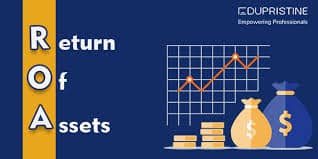Return on assets, or ROA, is a measurement that shows how well a business makes money from the things it already owns. ROA is a tool that managers, analysts, and investors use to analyze a company’s financial health. Furthermore, it’s a helpful metric for contrasting rival businesses in the same sector. The amount will differ significantly between industries. Return on assets is a measure of how much a company depends on its capital. Depending on the industry, companies that need a lot of money to start up tend to have a lower return on assets. In this article, we will be talking about how to calculate the return on assets with its formula, total returns on assets, and ratio.
Understanding Return on Assets (ROA): What ROA means
In the business world, effectiveness is everything. One useful operational statistic is the ratio of profits to revenue. Another is to compare profits to the resources used to make them, which shows if the business could actually stay in business. A simple and effective way to measure a company’s success is to look at its return on assets. It reveals the returns on a company’s money or assets.
Also, a public company in the technology sector is not likely to have the same return on investment (ROI) as a public company in the food and beverage sector. This is why comparing a company’s ROA to its own historical ROA data or the ROA of a comparable business is the most meaningful comparison that can be made.
Investors may see how efficiently a company turns its capital into profit by looking at its return on assets (ROA). The greater the return on investment, the better for a business. A higher return on assets (ROA) indicates a more productive use of capital.
Return on Assets Formula
The formula for calculating return on assets (ROA) is as follows:
ROA= Net income/ Average total assets
To calculate ROA, simply divide the net income by the average total assets of the company and multiply the result by 100 to get a percentage.
- Net Income: it is equal to net earnings in a financial year.
- Average Total Assets: it is equal to a sum of total assets for the current year and total assets for the previous year divided by two.
Although this formula is the most common method for calculating the return on assets, there are others. Also, it can be helpful for businesses outside of the financial sector to bring back interest payments to make up for the inconsistency that can happen when loan and equity capital are kept separate. If the return on assets formula is altered, the results will be different. The time units utilized in the calculations can differ between the various versions.
How To Calculate Return On Assets
A company is operating at peak efficiency when it can use its assets in the best way to make the most money on the bottom line. Also, a company’s profitability goes up when its capital and operating costs go down while it keeps making the same amount of product. This happens when its resources are used well.
Generally, businesses should try to get the most out of their operations while keeping costs low. This shows that processes are running at or close to their maximum capacity and efficiency.
The return on assets (ROA) ratio of a business is found by dividing its net income by its average total assets.
The calculated ROA is then given as a percentage, which makes it easier to compare similar businesses and see how things have changed over time.
Essentially, the total return on assets (ROA) seeks to respond to the question, “How much net income is the company making for each dollar of assets owned?” The average assets from the balance sheet are used as the denominator, and the net income from the income statement is used as the numerator.
Since the income statement reports on operations over a certain time frame while the balance sheet only shows a single point in time, the method uses the mean of the beginning and ending balances of the total assets during that time frame.
ROA Calculation Example
Here’s an example of how to calculate return on assets
Now that we have the formula for calculating the return on assets, let’s use it to solve an example.
A company’s return on assets would be calculated based on the amount of money it makes from its assets divided by the total amount of money it has in those assets, in this case, $50 million (balance sheet).
The return on assets is 20% since $10,000,000/$50,000,000 = 0.2. In other words, the corporation earns a yearly net profit of twenty cents for every dollar it invests in its assets.
What Does a Low ROA Mean?
If the percentage of return on assets is low, it means that the company needs to make more money from using its assets. Sometimes, even a moderate rate of return will do. For example, if a company just purchased an expensive piece of machinery for one of its manufacturing plants, the return on that asset may be low for the first few years of operation. But after the first few years, the return on that asset is likely to go up a lot.
If the return on investment stays low after the first few years, it may be an indication that management made an imprudent investment decision. It’s possible that the machinery isn’t making production more efficient or lowering overall production costs enough for the company’s profit margin to benefit.
Why is ROA so Important?
The return on assets ratio is an important accounting metric that shows how profitable a business is. It is often used to understand a company’s performance over different time periods and compare it with the current situation, or it is used to compare the performance of one company with that of another that operates on the same scale of operations in order to make a more informed decision. When comparing the success of two different businesses, it is important to keep in mind the size of each business as well as the operations it runs.
ROAs can vary widely depending on which sector of the economy is examined. A company with a lot of operations and a lot of fixed assets will have a lower ROA because its high asset values increase the value of the denominator in the ROA formula. This is because a company with a lot of operations that require a lot of capital and a high value of fixed assets to run has a lot of fixed assets. If the company’s income is also high enough, it could have a higher ratio.
ROAs can also be used to figure out if a company depends heavily or lightly on its assets. When the ROA is low, the company depends on its assets a lot. A company in the auto or airline industries, for example, might be expected to have a lower ROA.
The lower a corporation’s asset-intensive ratio, the greater its return on assets. Additionally, we are able to say that the company has a small number of assets. For instance, a software company or an advertising agency are examples of businesses that are not as dependent on their assets. Also, read Business Valuation: All you need to know [Detailed Guide]
Return On Assets Ratio
When figuring out how healthy a company’s finances are, you may not have enough information. The return on assets ratio is an important metric to compute and comprehend. Using the annual financial records that all publicly traded companies are required to make available to the public, calculating the return on assets ratio is a simple task.
Management and investors can also use this ratio to figure out how well the company turns its investments in assets into earnings, since the main purpose of a business’s assets is to bring in money and make money. Return on assets (ROA) is a return on investment for capital assets, a company’s most critical investment (ROI). Here, the firm is investing in fixed assets with the expectation of future financial gain.
Evaluation of Return on Assets Ratio
The ROA ratio measures how well an organization is able to make money from its assets. Simply, return on assets (ROA) measures how successfully an organization recoups the capital it invests in its assets.
Some investors try to ignore asset purchase expenses by adding interest costs back into the return calculation.
To make more sense, a higher ratio is better for investors since it indicates that the company is managing its assets efficiently, which in turn generates a larger net income. When the return on investment (ROI) is positive, profits are also likely to be on the rise. Due to the fact that different sectors make use of their assets in different ways, ROA is best used when comparing businesses operating in the same sector. Construction companies use big, expensive machines, while computers and servers are the backbones of the software industry.
What Is the Meaning of ROI and ROA?
Companies can assess their financial performance by looking at two types of numbers. These figures are from profit and loss statements and balance sheets. Return on investment and return on assets are both terms that describe the type of calculation that is used to provide financial experts and business leaders with a clear picture of how a company generates profits. Both of these calculations are used to determine a company’s rate of return on its assets. You’ll understand a company better and be able to support stakeholders and decision-makers if you know about these financial viewpoints.
What is ROI?
The term “return on investment” (ROI) refers to a method of calculating the financial gain from a certain financial outlay. Return on investment (ROI) helps businesses determine which investments will yield the highest returns. Return on investment (RO!) is used by investors as a guide in deciding where to put their money.
Also, businesses often use their return on investment (ROI) to decide:
- For the purpose of determining the returns on capital expenditures
- For the purpose of deciding whether or not to commit money to a deal
- Determine the rate at which a business can turn a profit.
- To determine an investment’s profitability before taking into account interest and principal
- The goal is to single out successful business strategies and personnel.
What are the Differences Between ROI and ROA
While both ROI and ROA can be used to gauge a company’s profitability, ROA provides a more nuanced look at the management of a business’s assets and investments in terms of how much profit they generate. The main distinctions between these two monetary estimates are outlined below:
#1. In Terms of Investment
The return on investment measures the financial gain from a company’s capital expenditures, while the return on asset measures the financial gain from its investments in things like machinery and computers.
Return on Assets measures how much money the company made from its primary shareholders. It also shows how much debt a company has compared to how much it has in assets. When figuring out ROA, you should think about how both equity and debt shareholders helped pay for the total assets.
Businesses use the basic ROI calculation to rapidly determine if an investment (or group of investments) is profitable.
#2. In Terms of Contrasting Several Companies
Comparing a company’s newest ROA calculation to its previous installments shows how it produces money from its assets. Using a comparable company within the same industry to evaluate ROA is also preferable. This is due to the fact that different kinds of assets have different required rates of return on investment.
The ROA of a restaurant could be based on the addition of outdoor seating, while the ROA of a factory could be measured after the purchase of new machinery. It’s possible that both assets can increase revenue, but they might affect a business’s bottom line in different ways.
Return on investment (ROI) is a way to measure how well money spent by a business on an unnamed asset or venture has paid off. ROI is a better way to measure how well management is maximizing the value for all stakeholders.
Conclusion
The return on assets (ROA) is an essential performance metric for any business. Amount of profit made in relation to total assets. It’s safe to assume that larger numbers indicate better returns. Investors can use return on assets (ROA) and return on equity (ROE) to assess a company’s performance. It’s useful for assessing a firm’s performance over time or against competitors.
Return on Assets FAQs
How do you interpret return on assets?
The return on assets is the amount of money earned per dollar of assets. So, a higher return on asset value means that a business is more profitable and efficient.
What happens when ROA is too high?
A company’s ROA rises as it makes more money from each dollar of assets.
What factors affect ROA?
ROA includes current and non-current assets. The income statement’s revenue and expenses also affect ROA.
Similar Articles
- WHAT IS ROI: Meaning, How to Calculate It, and Guide for A Business
- BEST AUTOMATION MARKETING SOFTWARE: Features and Pricing
- The Best 15 Return On Investment in 2023 (Updated)(
- MARKET RISKS: Best Practices and Easy Guide with Examples






